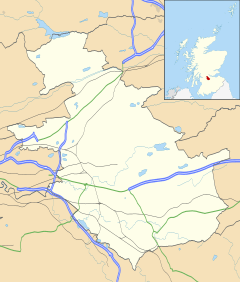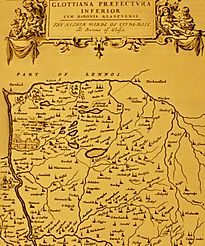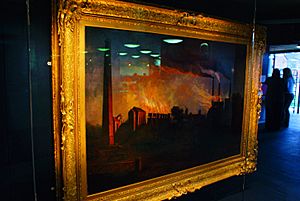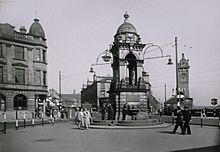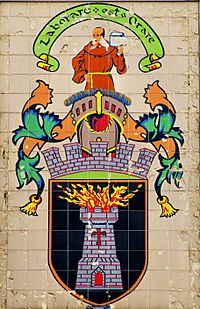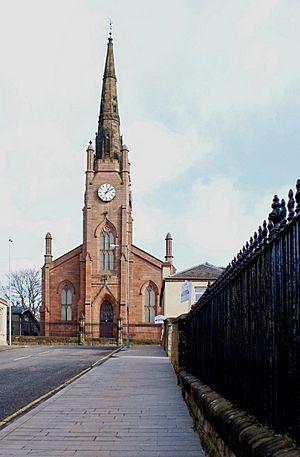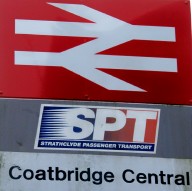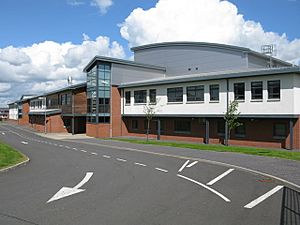Coatbridge facts for kids
Quick facts for kids Coatbridge
|
|
|---|---|
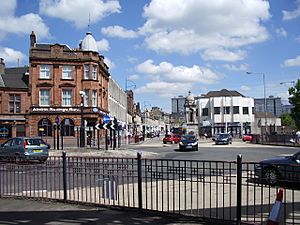 The Fountain at Bank Street |
|
| Area | 6.818 sq mi (17.66 km2) |
| Population | 43,950 (2020) |
| • Density | 6,038/sq mi (2,331/km2) |
| OS grid reference | NS730651 |
| • Edinburgh | 33 mi (53 km) ENE |
| • London | 341 mi (549 km) SSE |
| Council area | |
| Lieutenancy area | |
| Country | Scotland |
| Sovereign state | United Kingdom |
| Post town | COATBRIDGE |
| Postcode district | ML5 |
| Dialling code | 01236 |
| Police | Strathclyde |
| Fire | Strathclyde |
| Ambulance | Scottish |
| EU Parliament | Scotland |
| UK Parliament |
|
| Scottish Parliament |
|
Coatbridge (also known as Cotbrig or Coatbrig in Scots) is a town in North Lanarkshire, Scotland. It is located about 8.5 miles (13.5 km) east of Glasgow city centre in the central Lowlands. Coatbridge and its neighbour Airdrie together form an area called the Monklands. This area is often seen as part of the larger Glasgow urban area.
In the late 1700s, Coatbridge grew from small villages into a town. Its growth was strongly linked to new technologies during the Industrial Revolution. A key invention was the hot blast process, which made iron production much easier. During the 1800s, Coatbridge became a major Scottish centre for iron works and coal mining. It was even called 'the industrial heartland of Scotland' and the 'Iron Burgh'.
However, by the 1920s, most of the coal was used up, and the iron industry in Coatbridge began to shrink quickly. After the Great Depression, only one iron works, Gartsherrie, remained. Today, the town's past in coal, iron, and steel is mostly part of its history and heritage.
Contents
- History of Coatbridge
- Geography of Coatbridge
- Sports and Activities
- Coat of Arms
- People of Coatbridge
- Economy of Coatbridge
- Landmarks and Places to Visit
- Transport in Coatbridge
- Neighbourhoods of Coatbridge
- Education in Coatbridge
- Public Services
- Notable People from Coatbridge
- Twin Towns
- Images for kids
- See also
History of Coatbridge
The name Coatbridge has a few possible origins. It first appeared on maps in the 1800s, though an older map from 1750 shows 'Cottbrig'. This name might come from older Scots words: 'Cot' (meaning cottage) and 'brig' (meaning bridge). Locals sometimes still call the town 'The Brig'. Another idea is that the name comes from the Colt family, who owned land here around the 1200s. Their estate gave names to places like Coatbridge, Coatdyke, and Coathill.
Early Times: From Stone Age to Middle Ages
People have lived in the Coatbridge area for about 3,000 years, since the Mesolithic Age (Middle Stone Age). In 1852, a circle of Bronze Age stone coffins was found at the Drumpellier estate. Other Bronze Age items have also been discovered. An Iron Age dwelling called a crannóg (a house built on an island in a loch) was located in the loch at Drumpellier Country Park. You can still see its remains today when the water level is low.
Roman coins have been found in Coatbridge, and parts of a Roman road can still be seen near the M8 motorway.
From Middle Ages to the Late 1700s
The area got its name 'Monklands' because Cistercian monks from Newbattle Abbey were given the land by King Malcolm IV in 1162. The monks mined coal and farmed the land. Later, during the English Reformation, the land was taken from them and given to private owners. In 1641, the Monklands area was split into two parishes: New Monkland (now Airdrie) and Old Monkland (now Coatbridge).
In 1745, Bonnie Prince Charlie's Jacobite army took Coatbridge from government troops. This event was called the 'Canter of Coatbridge'. In 1799, Coatbridge was described as a beautiful 'immense garden' with 'extensive orchards' and 'luxurious crops'.
The 1800s: The Rise of Industry
The Monkland Canal was built in the late 1700s to transport coal from the rich local mines to Glasgow. In 1828, the invention of the hot blast furnace changed everything for Coatbridge. This new process meant that iron could be made using much less fuel. Summerlee Iron Works was one of the first to use this technology. By the mid-1800s, many hot blast furnaces were working in Coatbridge.
The booming iron industry needed many workers, especially for mining ironstone and working in the blast furnace plants. Because of this, many Irish people came to Coatbridge, especially from County Donegal in Ulster. The iron made in Coatbridge was used all over the British Empire for railways, buildings, bridges, and ships. For example, Coatbridge iron was used for armour plating on British ships during the Crimean War.
Over the next 40 years, Coatbridge's population grew by an amazing 600%. The town changed from a quiet, rural area with small farms into a busy, industrial town with many Irish Catholic residents.
One person at the time said that Coatbridge was "not famous for its beautiful scenery" but that a visit to the large Gartsherrie works was "one of the sights of a lifetime".
Most people lived in small terraced houses, often owned by their employers, right next to the iron works. Living conditions were very tough, and diseases like tuberculosis were common.
However, some people became very rich. The six sons of Alexander Baird, a Coatbridge farmer, were a great example. They started in coal mining but then opened an iron foundry to use the new hot blast process. They built many iron foundries in Coatbridge, including the famous Gartsherrie iron works. The waste heap from the Gartsherrie works was said to be as big as the Great Pyramid in Egypt! Each of Alexander Baird's six sons reportedly became a millionaire.
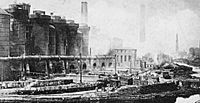
The Baird family had a huge influence on Coatbridge in the 1800s. They helped design the town centre. They gave land for the Town Hall and Dunbeth Park. They also built Gartsherrie church and donated the site for St. Patrick's Catholic Church.
The 1900s and 2000s
By 1885, most of the ironstone in Monklands was used up. It became very expensive to make iron in Coatbridge because raw materials had to be brought in from far away, even Spain. Also, the growth of the steel industry in nearby Motherwell meant less demand for the pig iron Coatbridge produced. Living conditions remained difficult.
In 1934, many people moved to Corby in England when a local factory relocated. This was a huge blow to Coatbridge's iron industry and marked the end of major iron production. The decline of the shipbuilding industry in the 1950s also caused the demand for iron to collapse completely. In the early 1930s, Coatbridge faced high unemployment, poor housing, and severe overcrowding. In fact, in 1936, it was the most overcrowded place in Scotland.
However, in the 1930s and 1950s, large government programs built thousands of new homes in Coatbridge. Many of the worst slum areas were cleared away. By the early 1980s, most homes in Coatbridge were council-owned.
The last blast furnace, William Baird's Gartsherrie works, closed in 1967.
Since the 1970s, there have been many projects to improve Coatbridge. Grants from Urban Aid, the European Union, and other partnerships have tried to bring new life to the town. Despite these efforts, the town's population has continued to decrease.
Geography of Coatbridge
 |
Gartcosh | Glenboig, Cumbernauld | Glenmavis |  |
| Glasgow | Airdrie, Edinburgh | |||
| Uddingston | Bellshill | Motherwell, Calderbank |
Coatbridge is located in Scotland's Central Lowlands. It is about 288 feet (88 metres) above sea level. The town is 9 miles (14 km) east of Glasgow, 6 miles (10 km) south of Cumbernauld, and 2 miles (3 km) west of Airdrie.
While no major river flows through Coatbridge, the North Calder Water runs to the south. The old Monkland Canal used to go right through the town centre towards Glasgow. You can still see parts of the canal route today. Several smaller streams, called burns, also run through Coatbridge, mostly flowing into the North Calder Water.
Coatbridge has four main public parks: Dunbeth Park, West End Park, Whifflet Park, and Drumpellier Country Park. Woodend and Witchwood Loch are two lochs on the north-west edge of Coatbridge.
Land Shape and Industry
The way the land is shaped in Coatbridge was very important for its growth during the Industrial Revolution. Coatbridge sits about 60 metres below the 'Slamannan plateau', which Airdrie is on. The flat, low ground of Coatbridge was perfect for building blast furnaces and for the route of the Monkland Canal. Even though Airdrie was an older town with ironstone nearby, the Monkland Canal couldn't reach it because Airdrie was too high up.
In 1949, a plan for the Clyde Valley described Coatbridge as being "situated over a flooded coalfield". Buildings in Coatbridge were not built as tall as those in Glasgow because of the risk of the ground sinking from centuries of mining.
Rocks and Ground
Dunbeth hill, where the local council buildings are now, is a piece of rock that was likely pushed up by two (now inactive) fault lines. There are also areas of glacial sands along Drumpellier, the west side of Gartsherrie Burn, and along Bank Street. Kirkwood, Kirkshaws, and Shawhead are on a sandstone ridge looking south over the Clyde Valley. The important Coatbridge black band coal field stretched from Langloan to the eastern edge of the town.
Weather in Coatbridge
Like most of the British Isles, Coatbridge has a temperate maritime climate. This means it has fairly cool summers and mild winters. The wind usually comes from the west. It rains regularly throughout the year, but usually not very heavily.
Sports and Activities
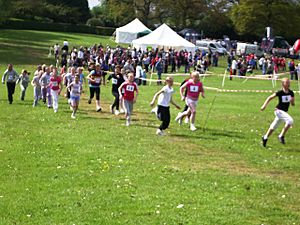
Coatbridge's local football team is Albion Rovers. They play in the Lowland Football League at their home ground, Cliftonhill. The "Wee Rovers" were formed in 1882 when two local clubs, Rovers and Albion, joined together.
Coatbridge CC, an amateur football club started in 1976, became Scottish Champions in 1986 and 1988. They were the first amateur club to win both the Scottish Cup and the West of Scotland Cup in the same season.
Coatbridge Bowling Club, founded in 1849, is the oldest sports club in the town. It will celebrate its 175th anniversary in 2024. The Coatbridge Indoor Bowling Club hosted the World Indoor Bowls Championships from 1979 to 1987.
Drumpellier Cricket Club has been active for over 150 years and has a ground in the Drumpellier area.
The town also used to have greyhound and speedway racing at the Albion Rovers FC ground. Greyhound racing took place from 1931 to 1986.
Coatbridge is known for several famous athletes. Boxer Bert Gilroy, Scotland's longest-reigning champion, was from here. Ricky Burns, a former world champion boxer in several weight classes, is also from Coatbridge. Walter Donaldson, a former World Snooker champion, also came from the town.
There are two golf courses: a public course next to Drumpellier Country Park and the private Drumpellier Golf Course. Clare Queen, a top Scottish female golfer, is from Coatbridge. The town even has a sumo club called Clan Sumo!
Coat of Arms
Coatbridge became a burgh (a type of town) in 1885 and received its own coat of arms in 1892. The coat of arms has a black background with a flaming tower, which represents a blast furnace and Coatbridge's industrial past. The crest shows a monk holding a stone. This stone relates to the old parish of Monklands and a legend about the 'aul' Kirk stane' (old church stone). The story says a pilgrim carried a stone from Glasgow and was told to build a church where he could carry it no further. That church is the present-day Old Monkland Kirk, and the stone can still be seen there.
The Latin motto 'Laborare est orare' means 'to work is to pray'. This saying comes from the writings of St. Benedict and is often linked to the Cistercian Order of monks who came to Monklands in the 1100s.
People of Coatbridge
| Coatbridge | North Lanarkshire | Scotland | |
|---|---|---|---|
| Total population | 41,170 | 321,067 | 5,062,011 |
| Born outside UK | 1.3% | 1.7% | 3.8% |
| Over 75 years old | 6.1% | 5.6% | 7.1% |
| Unemployed | 5.3% | 4.5% | 4.0% |
According to the United Kingdom Census 2001, Coatbridge had a population of 41,170 people. With an area of 6.818 square miles (17.66 km2), this means Coatbridge had about 6,038 people per square mile.
| Year | Population |
|---|---|
| 1755 | 1,813 |
| 1831 | 9,580 |
| 1851 | 27,333 |
| 1901 | 36,991 |
| 1911 | 43,286 |
| 1921 | 43,909 |
| 1931 | 43,056 |
| 1951 | 47,685 |
| 1961 | 54,262 |
| 1971 | 51,493 |
| 1981 | 48,445 |
| 2001 | 41,170 |
The average age for males in Coatbridge was 35 years, and for females, it was 38 years. About 34% of people were married, and 14.7% were single-parent families.
Most residents (98.7%) were born in the United Kingdom, with 96% from Scotland. A small number were from the Republic of Ireland (0.32%) or other European Union countries (0.30%).
During the 1800s, many Irish people moved to Coatbridge. The 1851 UK Census showed that 35.8% of the local population was Irish. Most of these immigrants were Catholic. By 1901, the percentage of Irish-born people had dropped to about 15%, but it was still the highest among major towns in Scotland. In the 2001 UK Census, about half the population identified as Roman Catholic.
In 2006, Coatbridge was noted for having a high percentage of Irish names, with over 28% of adults having names with Irish origins.
Other groups of immigrants have also settled in Coatbridge, including a small number of Lithuanians in the 1880s. In 1905, some immigrants from Monte Cassino in Italy came to Coatbridge. A small number of Polish people also stayed in Coatbridge after a Polish tank regiment was based there during World War II.
Economy of Coatbridge
Today, Coatbridge is home to Scotland's main inland container base. It was chosen for this because it is close to many rail and motorway networks. The company Tannoy Ltd., which makes PA systems and loudspeakers, has its headquarters in the town. Lees of Scotland, a local company that makes sweets and bakery products like the Lees Macaroon bar, has been operating in Coatbridge since 1931. William Lawson's Scotch Whisky distillery has been in the town since 1967. The oldest family business in Coatbridge and Airdrie is Donald McLaren Ltd, funeral directors, founded in 1912.
House prices in Coatbridge have increased a lot since 2000. In 2005, house prices went up by 35%, which was reportedly the biggest increase in Scotland.
Landmarks and Places to Visit
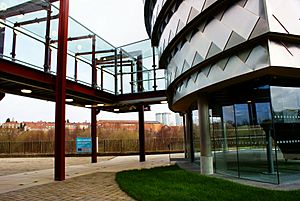
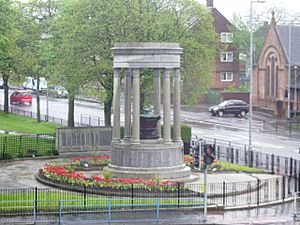
The buildings in Coatbridge town centre are a mix of old sandstone buildings from the late 1800s and early 1900s, and newer concrete shops from the late 1900s. The Blairhill and Dunbeth areas, to the west and north of the town centre, have lovely detached, semi-detached, and terraced sandstone homes. Most of the other areas have various local authority housing buildings from the 1900s. Several tall high-rise flats stand out in the skyline. As industries declined, new private housing estates have been built on old industrial land.
In 2007, Coatbridge received an award called the 'carbuncle award' for being called the 'most dismal town in Scotland'.
Drumpellier Country Park is a great place to visit, built around Lochend Loch (also known as 'Drumpellier Loch'). It has large woodlands, a visitor centre, and a butterfly house. The Monkland Canal also runs through part of the park.
The Time Capsule is a big leisure centre with a swimming pool, an adventure pool designed like a prehistoric environment, an ice skating rink, a sauna/steam room, and sports halls. The Showcase Leisure Park has a 14-screen cinema, a 10-pin bowling alley, and many restaurants.
Other important landmarks in Coatbridge include:
- Coatbridge Leisure Centre – a unique, modern building from the 1970s.
- The former Coatbridge Library – a grand pink sandstone building from 1905, supported by Andrew Carnegie.
- St Augustine's Church and buildings – a beautiful red sandstone Gothic church built in 1873.
- St Andrew's Church – an early Victorian Gothic church from 1839, whose tall steeple stands over the town centre.
- Coatbridge railway bridges – these bridges from 1898 span Bank Street, West Canal Street, and the old Monkland Canal. They were restored in 2009.
- St Mary's Church – a Gothic church in Whifflet designed in 1896, known for its fancy interior ceiling.
- The former Cattle Market Building – built in 1896, with a lovely sandstone front facing West Canal Street.
- Summerlee Heritage Park 2008 extension – a modern glass and metal addition to the existing museum building.
Transport in Coatbridge
The Monkland Canal (finished in 1791) was used in the 1800s and 1900s to move coal and iron to Glasgow. Part of the canal in the town centre was put into pipes in the mid-1970s. However, you can still see sections of the Monkland Canal today. Coatbridge is also close to the M8 and M73 motorways. The M74 motorway is also a short drive away. This means that major cities like Edinburgh, Stirling, and Glasgow are easy to reach for daily travel.
Because many railway lines run through Coatbridge, it was once called the "Crewe of the North". There are six railway stations in Coatbridge, located on four different lines: the Motherwell to Cumbernauld Line; the Argyle Line; the Whifflet Line; and the North Clyde Line. The six stations are: Blairhill; Coatbridge Central; Coatbridge Sunnyside; Coatdyke; Kirkwood; and Whifflet.
Coatbridge used to have other passenger stations, like Langloan and Calder Station, but these have been closed for many years.
McGill's Buses provides most of the bus services in the town. These buses connect all the main neighbourhoods, with some routes continuing to Airdrie, Plains, and Caldercruix.
Neighbourhoods of Coatbridge
The oldest map showing Coatbridge, from 1654, already shows districts like Dunpelder, Gartsherrie, Langloan, Kirkwood, Kirkshaws, and Whifflet.
Today, the neighbourhoods of Coatbridge include Barrowfield, Blairhill, Brownshill, Carnbroe, Cliftonhill, Cliftonville, Coatbank, Coatdyke, Cuparhead, Drumpellier, Dunbeth, Dundyvan, Espieside, Gartsherrie, Greenhill, Greenend, Kirkshaws, Kirkwood, Langloan, Old Monkland, Rosehall, Shawhead, Sikeside, Summerlee, Sunnyside, Townhead, and Whifflet. Victoria Park is a newer area near the town centre, built on land that used to be heavy industry. The Blairhill and Dunbeth areas are special conservation areas.
Whitelaw is the area where the town centre is located, though this name is not used much anymore. The fountain in the town centre, at the corner of Main Street and South Circular Road, is officially called the Whitelaw Fountain.
Education in Coatbridge
Coatbridge College was built in the 1860s as Scotland's first college. As Coatbridge moved away from heavy industries, the college's focus changed from traditional industry courses to business, care, and arts. In 2014, it became a campus of the larger New College Lanarkshire.
The main secondary schools in Coatbridge are St Ambrose High School (new building opened in 2013), St Andrew's High School (opened in 2006 after two older schools merged), and Coatbridge High School (new building opened in 2008). St Ambrose and St Andrew's are Roman Catholic schools. Coatbridge is one of the few places in Scotland where there are more religious schools than non-religious ones. Famous former pupils include singer Michelle McManus.
Coatbridge also has several special needs schools, such as Pentland School (primary), Portland High School, Drumpark School (primary department), Willowbank School (high school), and Buchanan High School.
Public Services
Coatbridge is part of the Western water and sewerage regions of Scotland. Waste management is handled by the North Lanarkshire local council. Scottish Water, a government company, provides water supplies. Scottish Power is the electricity provider for Coatbridge.
Coatbridge is served by Monklands Hospital, which is located on the Airdrie side of the border between Coatbridge and Airdrie. The local health board is NHS Lanarkshire. The Scottish Fire and Rescue Service provides fire and rescue services. Policing in Coatbridge is handled by Police Scotland (Lanarkshire Division). The Strathclyde Partnership for Transport helps manage local bus services and integrated ticketing. Transport Scotland manages the local rail network.
North Lanarkshire Council is the local authority responsible for community services in Coatbridge. They provide services related to education, social work, the environment, housing, road maintenance, and leisure.
Notable People from Coatbridge
Many well-known people have come from Coatbridge, including:
- Ricky Burns, a world champion boxer.
- George Graham, a famous footballer and manager for teams like Arsenal and Manchester United.
- Ayesha Hazarika, Baroness Hazarika, a broadcaster, journalist, and political commentator.
- Greg and Pat Kane, brothers who formed the 1980s band Hue and Cry.
- Mark Millar, a well-known comic book writer.
- Rev Dr Peter Marshall, a former Chaplain of the United States Senate, whose life story inspired the Oscar-nominated film A Man Called Peter.
- Johnny Russell, a footballer for Dundee United.
- John "Jock" Stein, a legendary football manager who led Celtic to win the European Cup in 1967.
- Tony Watt, a former Celtic FC striker.
Twin Towns
Coatbridge is twinned with several towns around the world:
- St. Denis, France
- Campi Bisenzio, Italy
- Gatchina, Russia
Images for kids
See also
 In Spanish: Coatbridge para niños
In Spanish: Coatbridge para niños


